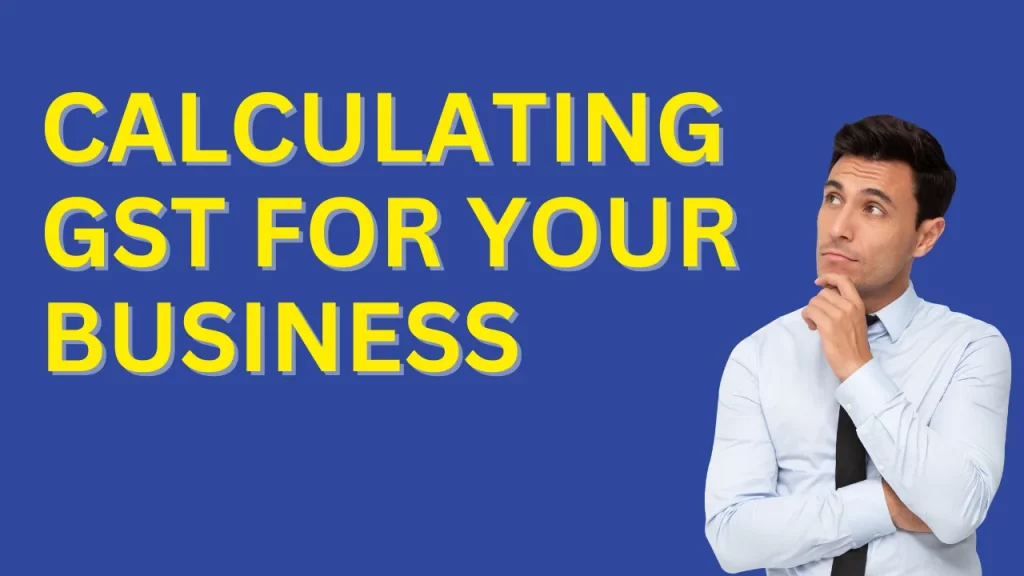Companies face complex hurdles when working with Goods and Services Tax (GST) regardless of their business size from small operations to large corporations. GST functions as a value-added tax business encounter throughout their complete supply chain network in almost every transaction. Businesses must collect GST from customers and send it to government authorities, although they do not pay taxes. Regarding electronic compliance, it is a prerequisite that the computation of GST must be accurate as the businesses must be aware of the correct methods of calculation to avoid incurring penalties.
This article provides simplified instructions to make tax obligation management easier for businesses. This guide will help you through key GST administrative steps including GST pricing calculations both GST-inclusive and GST-exclusive policy on exempt and taxable goods tracking and GST calculator usage. Your pricing strategy and GST record-keeping become more efficient when you understand GST rates for what you sell with their application.
Understanding GST Rates
The Goods and Services Tax (GST) applies different tax levels throughout India to create a tax system that matches the importance of products and services. GST policy imposes different taxation levels for businesses based on what they market. These rates are organized into the following primary slabs:
| GST Rate Slab | Applicable Goods/Services | Taxation Details |
| 0%(Nil-Rated) | Essential goods (Eg: French food and textbooks) | No Tax establishes carry no commercial taxation. |
| 5% | Everyday necessities (Eg: packaged foods, medicines) | A lower rate is applied to commonly used goods essential for daily life. |
| 12% | Intermediate goods (Eg: processed food, computers, mobile phones) | Moderate rate for goods and services that are essential but not necessarily luxuries. |
| 18% | Commonly used goods (e.g., toiletries, electrical appliances) | This is the most common rate, covering a wide range of goods and services |
| 28% | Luxury goods (e.g., high-end cars, tobacco, air-conditioned services) | The highest rate applied to luxury or non-essential goods and services. |
In addition to these primary slabs, special rates and cess are applied to particular items, such as luxury items, tobacco products, and aerated drinks.
| Special Rates | Goods/Services | Rate | Notes |
| 3% | Specific agricultural goods, fresh fruits | 3% | Lower rate for certain agricultural products. |
| 0.25% | Precious metals and jewelry | 0.25% | Applied to luxury items like gold and diamonds. |
| Cess | Luxury items (e.g., tobacco, high-end cars) | 1% to 204% | Additional tax on luxury and environmental impact items. CGST, SGST, and IGST Explained. |
The GST system provides for the distinction between transactions that occur within one state and the place between two states.
The differentiations are as follows:
CGST (Central GST) – Intra-state transactions (same state), Collected by the Central Government Collected on goods and services sold within the same state.
SGST (State GST) – Intra-state transactions (same state), Collected by the State Government alongside CGST on sales within the same state.
IGST (Integrated GST) – Covers interstate sales and transactions, (i.e., sales made across states) The Central Government collects the tax on sales from one state to another primarily to simplify tax collection.
Factors Determining GST Rates
The GST rate applied to a product or service depends on various factors:
- Nature of Goods/Services
Goods categorized as essential hold taxed rates at minimum levels (0% or 5%) whereas luxury items including cars or tobacco products maintain higher taxation rates (28%).
- Place of Supply
The distribution point for a transaction determines which tax rates will be used. Intra-state transactions require CGST and SGST but inter-state transactions require only IGST. Tax exemptions apply to exported goods.
The structure of taxation enables basic commodities to stay accessible to consumers yet rich products significantly support the financial market.
The Importance of HSN Codes for GST Rate Determination
The globally standard HSN (Harmonized System of Nomenclature) serves as a method to classify goods. Organizations operating under GST regulations depend on HSN codes to determine which GST rates should apply to their products.
For example:
| Product | HSN Code | GST % |
| Mobile phones | 8517 | 12% |
| Textiles | 6203 | 5% |
| Gold Jewellery | 7113 | 3% |
ALSO READ: New Tax Regime Slab Rates and Deductions Available
Calculating GST on Sales
Your business needs to follow three primary steps to calculate GST for sales beginning with GST rate determination and invoice GST calculation and ending with reverse charge mechanisms evaluation. Here’s a detailed breakdown:
Production and service categories need assessment for GST rating decisions.
Identify the Product/Service Category: A classification system groups products and services into distinct GST rate categories comprising zero per cent, five per cent, twelve per cent eighteen per cent and twenty-eight per cent benchmark rates.
| Product | Percentage |
| Exempt items | 0% |
| Essential goods | 5% |
| Standard goods | 12% |
| Common goods and services | 18% |
| Luxury items | 28% |
Use HSN/SAC Codes: Manufactured products and offered services require HSN (Harmonized System of Nomenclature) or SAC (Service Accounting Code) tags to determine which GST tax rates apply. Learning the correct HSN/SAC codes will help you prevent product misclassification.
Consider Place of Supply: The GST rate you must use depends on the location of the transaction because transactions within a state require dual collections of CGST and SGST yet those across states need to follow IGST procedures. Objects moved between states require payment of IGST.
Calculating GST Amount on Sales Invoices
To calculate the GST amount, you can use the following formulas based on whether the price is inclusive or exclusive of GST:
When Price is Exclusive of GST:
GST Amount= (Value of Supply * GST Rate / 100)
Total Price=Value of Supply + GST Amount
GST Amount=Value of Supply−(Value of Supply×100/100+GST Rate)
Example Calculation
Assume you are selling a product for Rs. 1,000 with an 18% GST rate:
- Exclusive Calculation:
- GST Amount = 1000×18/100=Rs.180
- Total Price = 1000+180=Rs.1180
- Inclusive Calculation:
- GST Amount = 1000−(1000×100/118) =Rs.180
Understanding the Concept of Reverse Charge Mechanism (RCM)
In certain transactions, reverse charge machinery taxes within the mechanism, transferring the tax liability from the seller to the buyer. In this case, when the buyer purchases goods or services from a supplier who is unregistered or from a registered person under a specific circumstance, the buyer himself will be liable to pay GST instead of the seller.
Example of RCM Calculation
If you purchase goods worth Rs. 10,000 with an applicable GST rate of 18%, under RCM:
- Total GST Payable =
- 10,000×18/100=Rs.1,800
Filing GST Returns
Certain returns under GST are very important concerning compliance under the Goods and Services Tax regime in India. Let us discuss various types of GST returns along with their due dates and guide you through the GST portal.
Different Types of GST Returns and Due Dates
The types of returns to be filed depend upon the category and registration type of a business. Some of the key returns are:
| GST Return Form | Description | Due Dates |
| GSTR-1 | supply all outward supplies (sales) during the tax period. | Monthly: 11th of every month Quarterly: 13th of the month following each quarter |
| GSTR-3B | A consolidated return containing details of outward and inward supplies and tax payments. | 20th or 22nd of every month, depending on the taxpayer’s turnover. |
| GSTR-4 | For taxpayers under the Composition Scheme, summarizing turnover and tax liability. | April 30th of the following financial year. |
| GSTR-5 | Filed by non-resident foreign taxpayers to report their transactions in India. | 20th of the next month. |
| GSTR-5A | OIDAR (Online Information Database Access or Retrieval) service providers. | 20th of the next month. |
| GSTR-6 | Filed by Input Service Distributors to report the distribution of input tax credit. | 13th of the next month. |
| GSTR-7 | Taxpayers are required to deduct Tax Deducted at Source (TDS). | 10th of the next month. |
| GSTR-8 | Filed by e-commerce operators for reporting supplies made through their platforms. | 10th of the next month. |
| GSTR-9 | An annual return summarising all monthly/quarterly returns filed during the financial year. | 31st December of the next financial year. |
| GSTR-10 | A final return is filed when a taxpayer’s GST registration is cancelled or surrendered. | Three months from the date of cancellation or date of cancellation order. |
| GSTR-11 | persons having a Unique Identity Number (UIN) can claim refunds on taxes paid on purchases. | 10th of the next month. |
ALSO READ: Income Tax Calculator 2025-26 in Excel
Input Tax Credit (ITC) and its Calculation
Input Tax Credit (ITC) is one of the most enthralling features of the GST system enabling businesses to ease their burden of the tax. Therefore, it is of extra benefit for registered persons, since any GST paid on purchases can be claimed by them against the total GST collected on sales.
Benefits of ITC for Businesses
Reduced Tax Liability – The tax liability has been reduced by the deductions available on included purchases.
Enhanced Cash Flow – A positive cash flow for adequate working capital due to ITC.
Cost Savings – Due to less tax burden realized, price competition of products and services would occur.
Encourages Compliance – Adequate documentation followed by regular filing will translate into tax transparency.
Who Can Claim ITC
To claim ITC, the user must fulfil these conditions:
GST Registration – The business has to be registered under GST.
Conduct Of Business – Purchases should only be used for business purposes.
Invoice Must Be Valid: A Tax Invoice or Debit Note from the Registered Supplier is needed.
Goods/Services Received– The business must have taken supplies before claiming ITC.
Payment in Time – Payments to the supplier must be made within 180 days to avoid ITC reversal.
How Is ITC Calculated on Purchases
Identify GST Paid – A list of all purchases eligible for ITC must include proof of GST paid.
Claim ITC – From total GST collected on sales, deduct all amounts of GST paid.
Check Limitations – Ensure the purchase is not for exempt supplies or personal use.
By drawing on these forward-looking measures, businesses would find it easy to assist their GST liability and shape up tax savings.
Tips for Simplifying GST Calculation
Managing GST is a complex task, these calculators and software tools have made this easy. Such tools enable companies to compute their GST simply, immediately lower their errors, and maintain compliance with the law. With these tools, tax calculations automatically happen for businesses.
A GST calculator establishes instant GST-inclusive and exclusive prices for accuracy and time savings. The GST software automates tax filing, invoice generation, and payment tracking, working to ease all brim, top tax management pitfalls. These tools likewise help businesses maintain their proper records and keep their compliance requirements in check without extra work.
Because GST is an area that stays on its toes for changes, businesses need to keep themselves well-versed. Online legal consultation can provide professional counsel to guide them about recent regulations and hence claim Input Tax Credit (ITC) and solve difficult tax issues. This knowledge can also help businesses convert prepared taxes into profit, not a penalty for non-compliance.
With the right GST tools, businesses save time, minimize errors, and increase efficiency. The Vakilsearch GST calculator and software solutions make the life of businesses easy with tax calculations and accuracy of filing compliances. With technology and expert facilitation, businesses could deal with GST affairs easily and concentrate on growth.
Conclusion
Managing GST expenditures and tax reporting begins with mastering GST rate definitions Input Tax Credit principles and filing return execution methods. Accurate tax filings require businesses to identify suitable GST slabs and GST calculation methods for sales while making good use of the RCM system. The implementation of GST calculators together with software solutions minimizes manual labor while reducing errors during these tasks.
The knowledge of the latest GST law developments and expert help will help you maintain GST compliance while maximizing your tax opportunities. Business operations streamline better through technological integration alongside expert support which enables improved business efficiency and continues the focus on growth. Your GST management process simplifies when you understand your GST obligations coupled with the correct management tools.
Save Home Loan Interest Amount!
Use Home Loan Excel Calculator that will help you to Save Interest Amount on Home Loan EMI.
Click below button to download Home Loan EMI and Prepayment Calculator in Excel:
Watch how Home Loan Calculator in Excel Works
Income Tax Calculator App – FinCalC
For Income Tax Calculation on your mobile device, you can Download my Android App “FinCalC” which I have developed for you to make your income tax calculation easy.
What you can do with this mobile App?
- Calculate Income Tax for FY 2025-26 and previous FY 2024-25
- Enter estimated Investments to check income tax with Old and New Tax Regime
- Save income tax details and track regularly
- Know how much to invest more to save income tax
- More calculators including PPF, SIP returns, Savings account interest and lot more

Use Popular Calculators:
- Income Tax Calculator
- Home Loan EMI Calculator
- SIP Calculator
- PPF Calculator
- HRA Calculator
- Step up SIP Calculator
- Savings Account Interest Calculator
- Lump sum Calculator
- FD Calculator
- RD Calculator
- Car Loan EMI Calculator
- Bike Loan EMI Calculator
- Sukanya Samriddhi Calculator
- Provident Fund Calculator
- Senior Citizen Savings Calculator
- NSC Calculator
- Monthly Income Scheme Calculator
- Mahila Samman Savings Calculator
- Systematic Withdrawal Calculator
- CAGR Calculator
I’d love to hear from you if you have any queries about Personal Finance and Money Management.
JOIN Telegram Group and stay updated with latest Personal Finance News and Topics.
Download our Free Android App – FinCalC to Calculate Income Tax and Interest on various small Saving Schemes in India including PPF, NSC, SIP and lot more.
Follow the Blog and Subscribe to YouTube Channel to stay updated about Personal Finance and Money Management topics.


